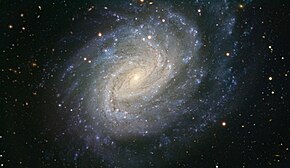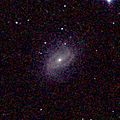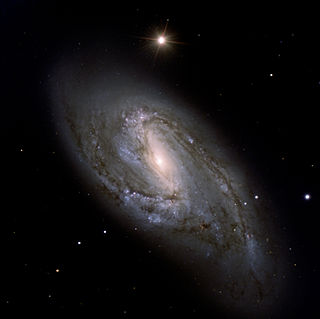
Messier 66 or M66, also known as NGC 3627, is an intermediate spiral galaxy in the southern, equatorial half of Leo. It was discovered by French astronomer Charles Messier on 1 March 1780, who described it as "very long and very faint". This galaxy is a member of a small group of galaxies that includes M65 and NGC 3628, known as the Leo Triplet or the M66 Group. M65 and M66 are a common object for amateur astronomic observation, being separated by only 20′.

NGC 1365, also known as the Fornax Propeller Galaxy or the Great Barred Spiral Galaxy, is a double-barred spiral galaxy about 56 million light-years away in the constellation Fornax. It was discovered on 2 September 1826 by Scottish astronomer James Dunlop.

NGC 1316 is a lenticular galaxy about 60 million light-years away in the constellation Fornax. It is a radio galaxy and at 1400 MHz is the fourth-brightest radio source in the sky.
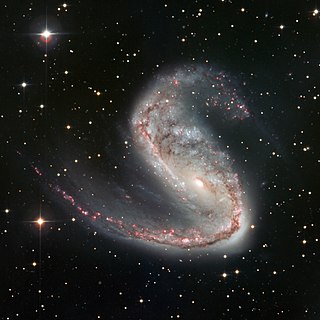
NGC 2442 and NGC 2443 are two parts of a single intermediate spiral galaxy, commonly known as the Meathook Galaxy or the Cobra and Mouse. It is about 50 million light-years away in the constellation Volans. It was discovered by Sir John Herschel on December 23, 1834 during his survey of southern skies with a 18.25 inch diameter reflecting telescope from an observatory he set up in Cape Town, South Africa. Associated with this galaxy is HIPASS J0731-69, a cloud of gas devoid of any stars. It is likely that the cloud was torn loose from NGC 2442 by a companion.

NGC 4945 (also known as Caldwell 83) is a barred spiral galaxy in the constellation Centaurus, visible near the star Xi Centauri. The galaxy was discovered by James Dunlop in 1826 and is thought to be similar to the Milky Way Galaxy, although X-ray observations show that NGC 4945 has an unusual energetic Seyfert 2 nucleus that might house a supermassive black hole. Around the nucleus of the galaxy, there is a dense disk of dust and gas, along with many dense star clusters. This object has an estimated mass of 1.4+1.4
−0.7×1011 M☉.

NGC 6744 is an intermediate spiral galaxy in the constellation Pavo (Peacock). Its velocity with respect to the cosmic microwave background is 802 ± 3 km/s, which corresponds to a Hubble distance of 38.6 ± 2.7 Mly (11.82 ± 0.83 Mpc). However, 21 non redshift measurements give a distance of 23.63 ± 1.68 Mly (7.244 ± 0.514 Mpc). It was discovered on 30 June 1826 by Scottish astronomer James Dunlop, observing from Parramatta, Australia.

NGC 4567 and NGC 4568 are a set of unbarred spiral galaxies about 60 million light-years away in the constellation Virgo. They were both discovered by William Herschel in 1784. They are part of the Virgo Cluster of galaxies.

Arp 271 is a pair of similarly sized interacting spiral galaxies, NGC 5426 and NGC 5427, in the constellation of Virgo. It is not certain whether the galaxies are going to eventually collide or not. They will continue interacting for tens of millions of years, creating new stars as a result of the mutual gravitational attraction between the galaxies, a pull seen in the bridge of stars already connecting the two. Located about 130 million light-years away, the Arp 271 pair is about 130,000 light-years across. It was originally discovered in 1785 by William Herschel. It is speculated, that the Milky Way will undergo a similar collision in about five billion years with the neighbouring Andromeda Galaxy, which is currently located about 2.6 million light-years away.
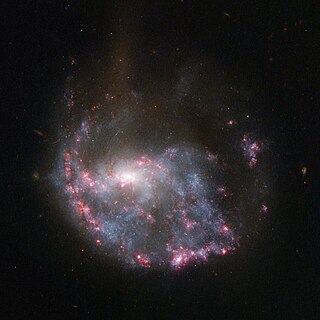
NGC 922 is a peculiar galaxy in the southern constellation of Fornax. Its velocity with respect to the cosmic microwave background is 2879 ± 15 km/s, which corresponds to a Hubble distance of 138.5 ± 9.7 Mly (42.46 ± 2.98 Mpc). Additionally, 17 non-redshift measurements give a distance of 138.88 ± 7.47 Mly (42.582 ± 2.291 Mpc). It was discovered by German-British astronomer William Herschel on 17 November 1784.

NGC 4527 is a spiral galaxy in the constellation Virgo. It was discovered by German-British astronomer William Herschel on 23 February 1784.
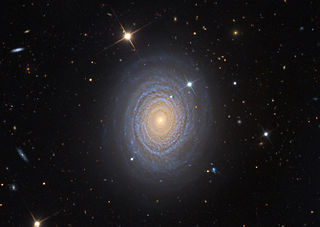
NGC 488 is a face-on spiral galaxy in the constellation Pisces. It was discovered by German-British astronomer William Herschel on 13 December 1784. It is at a distance of about 90 million light-years away from Earth. Its diameter is estimated to be 52,6 Kpc. The galaxy has a large central bulge, and is considered a prototype galaxy with multiple spiral arms. Its arms are tightly wound. Star forming activity has been traced within the arms. The nucleus of NGC 488 has been found to be chemically decoupled, being twice as metal rich as the central bulge of the galaxy. NGC 488, with the exception of its smaller companions, that form NGC 488 group, is an isolated galaxy.

NGC 1084 is an unbarred spiral galaxy in the constellation Eridanus. It is located at a distance of about 63 million light-years away from the Milky Way. The galaxy was discovered by William Herschel on 10 January 1785. It has multiple spiral arms, which are not well defined. It belongs in the same galaxy group with NGC 988, NGC 991, NGC 1022, NGC 1035, NGC 1042, NGC 1047, NGC 1052 and NGC 1110. This group is in turn associated with the Messier 77 group.
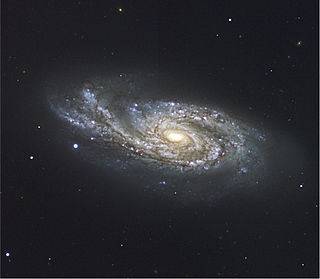
NGC 908 is an unbarred spiral galaxy in the constellation Cetus. It was discovered on 20 September 1786 by William Herschel. This galaxy is 56 million light years away from Earth. It is the main galaxy in the NGC 908 group, which also includes NGC 899, NGC 907, and IC 223.

NGC 337 is a barred spiral galaxy in the constellation Cetus. Its velocity with respect to the cosmic microwave background is 1,331±22 km/s, which corresponds to a Hubble distance of 64.0 ± 4.6 Mly (19.63 ± 1.41 Mpc). Additionally, 20 non-redshift measurements give a similar distance of 63.11 ± 1.81 Mly (19.350 ± 0.556 Mpc). It was discovered on September 10, 1785 by German-British astronomer William Herschel. It was described by John Dreyer as "pretty faint, large, extended, gradually a little brighter middle, 10th magnitude star 21 seconds of time to the east."

NGC 7038 is an intermediate spiral galaxy located about 210 million light-years away in the constellation of Indus. Astronomer John Herschel discovered NGC 7038 on September 30, 1834.

NGC 7083 is an unbarred spiral galaxy located about 134 million light-years away in the constellation of Indus. It is also classified as a flocculent spiral galaxy. NGC 7083 was discovered by astronomer James Dunlop on August 28, 1826.

NGC 2642 is a barred spiral galaxy in the constellation of Hydra. Its velocity with respect to the cosmic microwave background is 4632 ± 21 km/s, which corresponds to a Hubble distance of 68.32 ± 4.79 Mpc. It was discovered by British astronomer John Herschel on 19 February 1830.
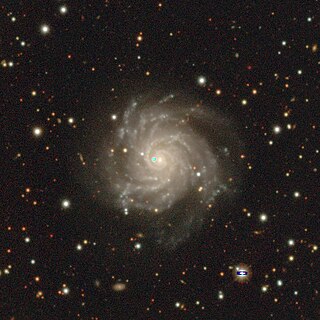
NGC 2466 is a spiral galaxy in the constellation of Volans. Its velocity with respect to the cosmic microwave background is 5428 ± 10 km/s, which corresponds to a Hubble distance of 261.2 ± 18.3 Mly (80.07 ± 5.61 Mpc). The galaxy was discovered by British astronomer John Herschel on 20 February 1835.

NGC 6492 is a spiral galaxy in the constellation of Pavo. Its velocity with respect to the cosmic microwave background is 4351 ± 8 km/s, which corresponds to a Hubble distance of 209.3 ± 14.6 Mly (64.17 ± 4.49 Mpc). In addition, five non redshift measurements give a distance of 183.10 ± 12.28 Mly (56.140 ± 3.766 Mpc). The galaxy was discovered by British astronomer John Herschel on 22 July 1835.

NGC 6754 is a barred spiral galaxy in the constellation of Telescopium. Its velocity with respect to the cosmic microwave background is 3176 ± 11 km/s, which corresponds to a Hubble distance of 152.8 ± 10.7 Mly (46.84 ± 3.29 Mpc). Additionally, 10 non-redshift measurements give a distance of 137.15 ± 4.19 Mly (42.05 ± 1.285 Mpc). It was discovered by British astronomer John Herschel on 8 July 1834.
